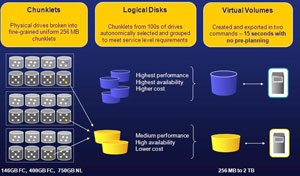3PAR Storage Architecture, Protection Notes
At last week's
Gestalt IT Field Day, I saw a series of
3PAR demonstrations using storage connected to a vSphere installation.
Architecturally, 3PAR storage maintains good access between each controller and set of disks. The key technology to deliver the individual paths between disk and controller is 3PAR's mesh-active technology. This is where each volume is active on every controller on the array with its own connection (fibre channel, iSCSI, etc.). For VMware installations, this is a fully supported configuration on the hardware compatibility list.
Redundancy and data protection is also a critical point of the 3PAR storage offering. In that day's discussion, a description of why storage protection is important is made very simple by comparing networks and storage. Loosely quoting the presenter at 3PAR, if the network drops one packet in a million, nobody cares. If the storage network drops a single packet in a billion, it can be data destructive to storage resources. This is especially important in virtualized environments, where entire LUNs or virtual machines can be affected.
During the demonstration, a controller failure was evoked. We quickly saw a dip in the I/O, but a seamless recovery quickly followed. This unplanned event is transparent to the operating systems, which is an important distinction. From a behavior observation, it may feel like when a virtual machine is paused. What you don't see is hard disk errors in the event log. Applications may report timeouts, but won't report a loss of access to the storage.
3PAR storage systems also use an on-disk chunklet. This allows many disks to be accessed simultaneously to increase disk access speed. All physical disks are broken into chunklets at 256 MB. Each of these 256 MB chunklets is viewed as an individual disk. Logical drives contain the chunklets and are organized by a number of ways. One of these practices is to not allow chunklets in the same logical drive to exist on both SAS and SATA storage, and this is common on many storage platforms.
3PAR goes further with the chunklets to prevent hotspots on disks of busy chunklets with tools such as dynamic optimization that will spread the hot chunklets around to protect disk performance. Without the dynamic optimization feature, the alternative is a random I/O of the chunklets, which works for most environments. Fig. 1 shows how chunklets exist on disk.
 |
| Figure 1. The 3PAR chunklets are shown across a large collection of disks and how they are represented in logical disks and virtual volumes. (Click image to view larger version.) |
I am a fan of built-in efficiencies for storage environments, especially in virtualized environments. This is similar to the VMware's vStorage VMFS file system. I really like the VMFS sub-blocks to eliminate waste on the disk.
Disclosure: I am attending this event and have been provided airfare, meals and accommodations by the event organizer. The opinions mentioned above are a result of an in-person demonstration of the technologies discussed.
Posted by Rick Vanover on 11/17/2009 at 12:47 PM